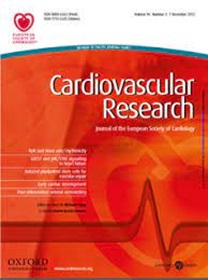Recaticimab治疗成人杂合性家族性高胆固醇血症(remain3):一项多中心、随机、双盲、安慰剂对照的3期研究
IF 13.3
1区 医学
Q1 CARDIAC & CARDIOVASCULAR SYSTEMS
引用次数: 0
摘要
目的杂合子家族性高胆固醇血症(HeFH)是一种遗传性疾病,其特征是出生时血浆中低密度脂蛋白胆固醇(LDL-C)浓度高。该研究旨在评估recaticimab的有效性和安全性,recaticimab是一种新的人源化抗pcsk9抗体,能够降低控制不良的HeFH患者的LDL-C水平。方法和结果REMAIN-3是一项多中心、随机、双盲、安慰剂对照的3期研究,在中国25个地点进行。遗传或临床诊断为HeFH的患者,接受稳定降脂治疗≥28天,空腹LDL-C≥2.6 mmol/L(或有动脉粥样硬化性心血管疾病病史者≥1.8 mmol/L),空腹甘油三酯≤5.6 mmol/L,按2:1的比例随机分配,每4周接受150 mg皮下recaticimab或匹配安慰剂治疗,持续12周。主要终点是LDL-C从基线到第12周的百分比变化。总体而言,143名患者接受了随机分组,并接受了recaticimab (n = 95)或安慰剂(n = 48)。在第12周,recaticimab组LDL-C较基线的平均百分比变化为-54.4% (95% CI, -57.9%至-50.8%),安慰剂组为-4.5% (95% CI, -9.4%至0.3%),治疗差异为-49.8% (95% CI, -55.8%至-43.9%;p < 0.0001)。在改善其他脂质变量(包括非高密度脂蛋白胆固醇、载脂蛋白B和脂蛋白a)方面,recatiimab优于安慰剂。治疗相关不良事件(TRAEs)在两组之间具有可比性(recatiimab组为27.4%,安慰剂组为25.0%)。recatiimab组比安慰剂组更常见的TRAEs是注射部位反应(8.4%比0%)和血肌酸磷酸激酶升高(5.3%比2.1%)。结论与安慰剂相比,recatiimab可显著降低LDL-C水平,且具有可接受的安全性,为控制不充分的HeFH患者提供了一种新的有效治疗选择。ClinicalTrials.gov标识符NCT04844125本文章由计算机程序翻译,如有差异,请以英文原文为准。
Recaticimab in adult heterozygous familial hypercholesterolemia (REMAIN-3): A multicentre, randomised, double-blind, placebo-controlled phase 3 study
Aims Heterozygous familial hypercholesterolemia (HeFH) is a genetic disorder, characterised by high plasma concentrations of low-density lipoprotein cholesterol (LDL-C) from birth. This study aimed to assess the efficacy and safety of recaticimab, a new humanised anti-PCSK9 antibody capable of reducing LDL-C levels in patients with poorly controlled HeFH. Methods and Results REMAIN-3 was a multicentre, randomised, double-blind, placebo-controlled phase 3 study done at 25 sites in China. Patients with a genetic or clinical diagnosis of HeFH, who were on stable lipid-lowering therapy for ≥28 days, had fasting LDL-C ≥2.6 mmol/L (or ≥1.8 mmol/L for those with a history of atherosclerotic cardiovascular disease), and had fasting triglyceride ≤5.6 mmol/L, were randomly allocated in a 2:1 ratio to receive subcutaneous recaticimab at 150 mg or matching placebo every 4 weeks for 12 weeks. The primary endpoint was the percentage change in LDL-C from baseline to week 12. Overall, 143 patients underwent randomisation and received recaticimab (n = 95) or placebo (n = 48). At week 12, the mean percentage change in LDL-C from baseline was -54.4% (95% CI, -57.9% to -50.8%) in the recaticimab group and -4.5% (95% CI, -9.4% to 0.3%) in the placebo group, with a treatment difference of -49.8% (95% CI, -55.8% to -43.9%; p < 0.0001). Recaticimab was superior to placebo in improving other lipid variables, including non-high-density lipoprotein cholesterol, apolipoprotein B, and lipoprotein a. Treatment-related adverse events (TRAEs) were comparable between groups (27.4% with recaticimab vs. 25.0% with placebo). The most common TRAEs occurring more frequently with recaticimab than placebo were injection site reaction (8.4% vs. 0%) and increased blood creatine phosphokinase (5.3% vs. 2.1%). Conclusions Recaticimab significantly lowered the LDL-C level compared with placebo, with an acceptable safety profile, providing a new effective treatment option for patients with inadequately controlled HeFH. ClinicalTrials.gov Identifier NCT04844125
求助全文
通过发布文献求助,成功后即可免费获取论文全文。
去求助
来源期刊

Cardiovascular Research
医学-心血管系统
CiteScore
21.50
自引率
3.70%
发文量
547
审稿时长
1 months
期刊介绍:
Cardiovascular Research
Journal Overview:
International journal of the European Society of Cardiology
Focuses on basic and translational research in cardiology and cardiovascular biology
Aims to enhance insight into cardiovascular disease mechanisms and innovation prospects
Submission Criteria:
Welcomes papers covering molecular, sub-cellular, cellular, organ, and organism levels
Accepts clinical proof-of-concept and translational studies
Manuscripts expected to provide significant contribution to cardiovascular biology and diseases
 求助内容:
求助内容: 应助结果提醒方式:
应助结果提醒方式:


